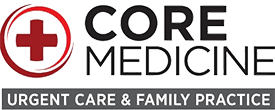Don’t Take Chances with Mononucleosis: Our Caldwell, Idaho Urgent Care Can Help You Get Back on Your Feet
Mononucleosis is a common type of virus that spreads through saliva. Although it’s not nearly as infectious as influenza or the common cold, it transmits easily through close physical contact. In fact, mono is so closely associated with intimacy that it’s sometimes referred to as the “kissing disease.” However, people are just as frequently exposed to it when they share cups and utensils as when they kiss.
Most cases of mononucleosis are mild or moderate, but this illness can trigger serious symptoms that last for weeks. Learn more about mononucleosis and its management, or contact Core Medicine of Idaho today to request an immediate appointment at our Caldwell urgent care clinic.
Table of Contents
An Overview of Mononucleosis
Mono can be caused by exposure to several different pathogens, with the most common culprit being the Epstein-Barr virus. It’s almost always spread through contact with an infected person’s saliva. Exposure is possible during or after:
- Kissing
- Sharing food or drinks
- Sharing glasses or utensils
- Touching toys and other objects that have been in contact with saliva
Most adults have been exposed to mono in the past and won’t fall ill even if they’re exposed to somebody who’s sick and symptomatic. It’s more commonly diagnosed in children, teenagers, and young adults than it is in more mature people.
Most Common Symptoms of Mono
This illness triggers a wide range of symptoms including, but not limited to:
- Feelings of intense fatigue, similar to a bad case of the flu
- A sore throat that doesn’t respond to antibiotic treatment
- Fever
- Recurring headaches
- Skin rashes
- Swollen lymph nodes in your neck and in your armpits
- Soft, swollen skin around the spleen
![Managing Mononucleosis in Idaho]()
Mononucleosis symptoms don’t emerge immediately after exposure. On average, most cases take between four and six weeks to become symptomatic. This means by the time you start feeling sick, you may not be able to connect your illness with its source.
How Medical Professionals Diagnose Mononucleosis
Since mono is a viral infection, a diagnosis can only be confirmed through medical testing. Some of the most common methods include:
- Physical examinations. Your provider may be able to diagnose it after performing a physical examination. During a typical exam in our Caldwell urgent care clinic, one of our providers will ask questions about your symptoms and inspect your body for signs such as swollen lymph nodes, spleen, or tonsils.
- Antibody tests. We can also confirm a mononucleosis diagnosis by taking a small sample of blood and running a monospot test, which returns results in 24 hours or less. However, monospot tests aren’t always reliable, as they sometimes fail to detect early-stage infections.
- White blood cell count tests. Your provider can determine whether you’re fighting an infection by looking at your white blood cell count. High counts indicate infection, but additional testing is required to determine causation.
Mononucleosis can’t be cured, but many different types of medication effectively eliminate uncomfortable symptoms like sore throat and fever. Your urgent care provider will refer to the results of your interview, physical examination, and blood tests to decide on the best course of action.
Why You Can’t Afford to Ignore the Signs of a Mononucleosis Infection
Mono isn’t typically considered a serious illness. However, if left untreated, it could cause severe complications such as:
- Enlargement of the spleen
- Inflammation of the liver
- Jaundice
- Anemia
- Myocarditis
Other mononucleosis-related complications, like an enlarged spleen or inflamed liver, are rare but life-threatening.

